Thank you to all of the students who participated in the 2024 SCHLUEBarchitecture Student Design Competition. Congratulations to the Finalist designs (listed below with links to their designs). The submissions were judged anonymously by artists Erin O’Neill and William Kofmehl, along with architect Matthew Schlueb, selecting winning designs based on creativity, visionary innovation in the house concept and clarity of presentation.
FINALISTS:
Ojasi Madhekar’s design was organized clearly, illustrating many of the key features, demonstrating how the house functioned and considered possibilities for new innovations to enhance the living experience and conserve vital resources.
Kiran Rihn’s design was skillfully staged with the tone created from a poem written to present the concept for a house set in a future society thriving in abundance and hope, adapted from an old structure of a past warfare age.
Nat Winter’s design featured a future living small, responding to over-population, with tiny homes that offer efficient use of space and affordability, that can be customized with add-ons to address the homeowner’s needs.
Radomir Bryzgalov’s design uses levitating flying houses stacked vertically within modular housing blocks, to maximize efficiency of space in an over-populated future with urban congestion and dwindling land space for construction.
Noah Greep’s design imagines a city of the future, floating in rising sea waters, with jellyfish-like structures, each tenacle with individual houses layered atop each other like apartments connected by transportation tubes to the center city hub, modeled with 3D printer.
Shamar Parke’s design for a future house with maximum flexibility to live in any environment or circumstance dealing with isolation for quarantining against viral spread or secluded luxury, the building form varied to be independent of whatever site it is located.
Leuel Eshetu and Jesse Nelson’s design for a stress relieving house is inspired by a fidget spinner toy, utilizing the same rotating principle for propellers and superconductor diamagnetic materials to levitate off the ground and complete freedom to move around.
Julius Franklin and Gabriel Cornman’s design asked the question, why should we put plants on buildings? and created a model using actual plant materials, demonstrating the biodiversity, aesthetic enhancement, and environmental benefits of air purification, shading and stormwater absorption.
Logan Jacobina and Wesley Chung’s Design, a fresh and modular idea, was fun and could be practical, as illustrated by the fixtures and furnishings included within the interiors of the three-dimensional perspective renderings.
These Finalist designs will be exhibited during the 2024 Round Table Forum hosted at the Fox Chapel Golf Club later this Fall, discussing and debating the future of housing. Finalist students will be invited on a guided tour of the Troy Hill Art Houses and the opportunity to shadow Matthew Schlueb this Summer, assisting with the design and construction of his current residential projects.


